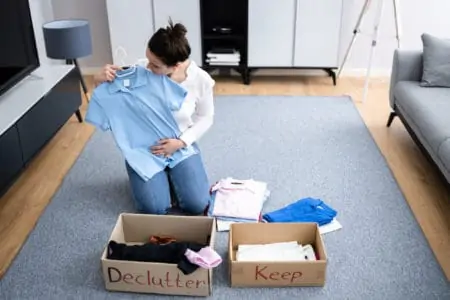Hoarding is a disorder that many people face. It involves the inability to throw out items, the longing to keep items, and a habit of accumulating things and living in clutter. Not only is this unhygienic, but it causes stress and limits a person’s quality of life.
If you’re interested to know more about this disorder, we have 45 hoarding facts and statistics that might intrigue you.
We’ll cover facts about hoarding in America, hoarding by gender, hoarding symptoms, and more.
Top 10 Hoarding Facts and Statistics
- Between two and six percent of people in America have a hoarding disorder.
- Animal hoarding is common. People tend to keep dozens, if not hundreds, of animals.
- Hoarding can run in the family — you’re more likely to inherit the disorder if you live with a hoarder.
- Hoarding symptoms and habits differ between men and women. For instance, male hoarders have a more difficult time discarding items.
- Male hoarders are more likely to have anxiety disorders, while female hoarders are more likely to have social phobia or body dysmorphic disorder.
- About 40 percent of men and women with OCD have hoarding behavior.
- Hoarding symptoms include difficulty throwing possessions away, anxiety about certain items, disorganization, and distractibility.
- Hoarding is often associated with other mental illnesses like depression and ADHD.
- Traumatic events such as death or chronic stress can trigger hoarding.
- Hoarding might be genetic. There is evidence that hoarding is linked to a unique pattern on chromosome 14.
Hoarding Statistics in America
Hoarding is prevalent worldwide. But we’re going to look at some interesting information about hoarding in the US. This includes how many people it affects, what types of people, and what drives the increase in hoarding behavior.
- 2.6 percent of people hoard: One study found that approximately 2.6 percent of people have hoarding disorder (1). Another study found that it affects around six percent of Americans, which is 19 million people.
- Certain people hoard more: People over 60 hoard more than other age ranges. Plus, people with depression, anxiety, and other psychiatric diseases are more likely to be hoarders.
- Animal hoarding is quite common: An example of hoarding in America is animal hoarding. This involves a person keeping dozens, or even hundreds, of pets. Not only is this unhealthy, but it’s also unsafe for the animals.
- Hoarding can start as young as 15: American studies show that hoarding typically starts between the ages of 15 and 19. The hoarding tendencies become worse as a person ages.
- There are hoarding assessment scales: When a person is thought to have hoarding issues, there are ways to determine how severe they are. There are four main scales that America uses. These include the Structured Interview for Hoarding Disorder, the Clutter Image Rating, the Saving Inventory-revised, and the Hoarding Rating Scale-Interview.
- Is hoarding linked to capitalism?: While there’s no evidence yet, it’s thought that the rise in hoarding correlates with America’s culture of consumerism and greed (2).
- Only recently has it been taken seriously: It’s pretty new that American psychologists, social workers, and researchers have taken hoarding seriously. It’s now considered a psychiatric condition.
- Hoarding runs in the family: In America, it’s thought that hoarding runs in the family. Living with someone who hoards makes you more likely to inherit the condition.
- More than 100 task forces: In the last five years, there have been more than 100 task forces on hoarding throughout the United States and Canada. The staff is trained and educated on recognizing and coping with the disorder.
- Hoarding is linked to homelessness: In America, it’s found that 22 percent of people threatened with an eviction had a hoarding problem. This leads to hoarding having a direct link to homelessness.
- What do people hoard?: Anything, but the most common items include books, papers, clothes, photographs, containers, and even food (3).
Hoarding Statistics by Gender
Hoarding is a real issue for men and women. But it presents itself differently. These insightful hoarder facts and statistics shed light on the various ways hoarding shows up in both men and women.
- More women might be hoarders than men: The facts are a bit iffy. In one study of self-identified hoarders, 78 percent of self-proclaimed hoarders were women (4). But in other studies, there were no gender differences found, meaning that men and women equally have this condition.
- Men may have more difficulty discarding: A study found that men had more difficulty discarding items than women. Even further, men with psychosis found it especially difficult.
- Men scored higher on the hoarding scale: Earlier, we mentioned one of the hoarding scales used to diagnose. It’s called Saving Inventory-revised. Men score higher than females in this test.
- Men have specific hoarding associations: Studies find that among male hoarding, the disease is associated with aggressive, religious, and sexual obsessions (5). It is also associated with checking compulsions. Checking compulsions involve checking something repeatedly, such as a light switch being turned off or a door being locked.
- Women’s hoarding associations: Women’s hoarding symptoms are more likely to be associated with “schizotypal and dependent personality disorder dimensions” and low conscientiousness.
- Men and women display different symptoms: Male hoarders might also have anxiety disorder and tics. On the other hand, women are more likely to have social phobia, body dysmorphic disorder, PTSD, or a skin-picking disorder.
- Women’s links to OCD: Women with hoarding disorder have an earlier onset of OCD than women without hoarding disorders. The OCD is typically more severe and can accompany bipolar disorder, panic disorder, alcohol and substance abuse and addiction, and binge eating.
- Men’s links to OCD: It’s found that the only difference between a man with OCD, and a man with OCD and hoarding disorder, is a more prevalent social phobia and symmetry obsession.
- Men, women, and OCD: One study found that 40.4 percent of men and 38.5 percent of women with OCD have hoarding behavior.
- Common hoarding compulsions: Of the men and women studied, the most prevalent compulsions of hoarders included checking, cleaning, and ordering.
- Female hoarders have trouble finishing tasks: 43 percent of female hoarders have challenges starting and finishing tasks. This result was not found in male hoarders.
- Women are more likely to seek help: While hoarding is pretty much just as prevalent in men and women, women are more likely to seek and accept help.
Hoarding Disorder Symptoms
Knowing the main hoarding signs can be helpful — and interesting. Collecting stuff isn’t the be-all and end-all. If you’re worried about someone you know becoming a hoarding, here are some ways the disorder presents itself.
- Difficulty throwing possessions away: Hoarders find it super challenging to throw away possessions, even if they don’t hold any value, financially or sentimentally. They feel they need to save the items. Discarding things is distressing.
- Cluttered and congested areas: Their home isn’t just a little untidy; it’s cluttered and cramped. You might be unable to see the floor or access vital parts of a home, such as a washing machine, stove, or sink.
- Embarrassed about their home: Hoarders typically feel embarrassed about how their living space looks. If you notice somebody is nervous or embarrassed to show you their home or have you round — it could be a hoarding problem.
- Anxiety about items: If you ask a hoarder to throw something out, they might express extreme anxiety and worry about needing that item again in the future.
- Disorganized and uncertainty: When trying to organize a home, a hoarder will have uncertainty about where to put things (6). They are highly unorganized.
- Protective about items: Hoarders are not trusting of other people touching their possessions.
- Withdrawal from family: Hoarders might slowly withdraw from their friends and family. Thus, they end up living an isolated life.
- Cognitive dysfunction: Many people with hoarding disorder also have trouble with indecisiveness, perfectionism, procrastination, disorganization, and distractibility.
- Acquiring or buying new things: Even if someone doesn’t have space, a person with hoarding disorder will keep acquiring new things.
- The home is unsanitary: Too much clutter is unsanitary. If a person’s home is unhygienic and there is excess food, food waste, and trash, they may be a hoarder.
- The home is unsafe: The home becomes an unsafe place. There are fire hazards and tripping hazards. The hoarder and others in the home find it extremely distressing to keep other people safe while in the house.
5 Stages Of Hoarding
You may hear about the five stages of hoarding. This refers to the various levels of hoarding, with one being concerning and five being severe. This ranges from clutter without cleaning up to severe unsanitary conditions.
Interesting Hoarding Facts
There are still a few more things we want to share about hoarding. These extra facts are worth noting. Plus, they’re quite eye-opening!
- Hoarding is associated with other mental illnesses: Hoarding rarely shows up as a singular psychiatric disorder. It’s often hand in hand with major depression, ADHD, and poor general health (7).
- Traumatic events trigger hoarding: It’s common for hoarding to set in or worsen after a traumatic event, such as chronic stress, grief, or other major life events.
- There is no medication for hoarding: There are no medications to treat hoarding, despite the fact it is a psychiatric disorder. However, some studies have found that serotonergic drugs can benefit people with hoarding disorder. This can calm the obsessive spectrum, anxiety, insomnia, and depressive symptoms.
- Hoarding differs from collecting: Collecting involves saving a few items of choice within one category, such as stamps. Collectors typically keep the items extremely organized and they don’t impact daily life. Hoarding is the disorganized keeping of items that are not valuable or relevant, such as broken toys or paper.
- People with processing deficits are more likely to hoard: People who have issues with planning, problem-solving, memory, attention, and organization are more likely to hoard.
- Risk factors of hoarding: Major risk factors associated with hoarding include brain injury, impulsive shopping, substance and alcohol abuse, and Prader-Willi syndrome (8).
- Treatment for hoarding disorder: If you reach out for help, treatment therapies will include cognitive behavior therapy or antidepressant medication (CBT). CBT is a type of talk therapy where a psychologist will help you understand why you hoard. They will help manage the anxiety you feel when you have to throw things away, which can help you organize your home again.
- The prognosis for hoarding is poor: Even after CBT, results are poor. While treatment is helpful temporarily, many people still struggle with hoarding and its impact on their daily life. Hoarding can affect a person’s ability to cook, clean, sleep, and wash themselves.
- Hoarding brings on complications: Hoarding disorder has many risks. This includes a tripping or falling risk, injury from being trapped under items, unsanitary living conditions, and fire hazards. It can also contribute to family conflicts, loneliness, poor work performance, and eviction from rental properties.
- How to help a person with hoarding: Cleaning a person’s home won’t help. Continue to offer help until the person accepts, but stop any time they become distressed. Remain empathetic, team up with a trusted team, and don’t treat it like a funny issue.
- Hoarding disorder might be genetic: There is evidence that a compulsive hoarding disorder is linked to a unique pattern on chromosome 14 (9). This is especially true for people who have relatives who hoard. For people that don’t have relatives who hoard, there is a linkage to chromosome three.
FAQs
Hoarding These Facts
Tuck these hoarding facts and statistics aside and keep them in your mind. You never know when they might come in handy. You might be able to recognize hoarding tendencies in yourself or somebody you know.
Remember that hoarding is a psychiatric disorder and should be treated with empathy and sympathy. Reach out to a doctor if you need help, as cognitive behavioral therapy and antidepressants can help.









